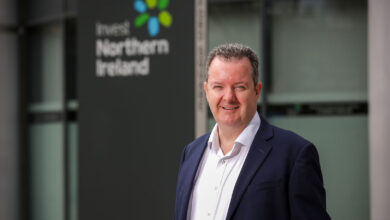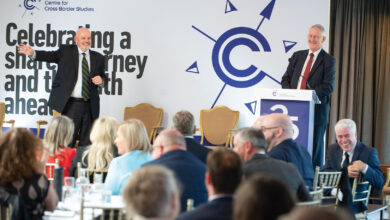Northern Ireland’s health options
 Allowing clinicians to invest surpluses and strong political leadership can help the Health Service cope with austerity, Gordon Marnoch writes.
Allowing clinicians to invest surpluses and strong political leadership can help the Health Service cope with austerity, Gordon Marnoch writes.
Northern Ireland faces extremely challenging times in meeting its commitments to maintain standards of service in health and social care. As the Assembly budget process moves forward, it is worth considering the English and Scottish predicaments.
In Scotland the SNP Government is committed to ring-fencing health spending. The block grant to Scotland will fall by £1.8 billion next year, which means local government spending will need to fall by 18 per cent by 2014 if the NHS is ‘spared’. This is a high risk, make or break issue for the Scottish Government.
In England the Coalition Government is also pledged to ring-fence the NHS from cuts. The October spending review left the NHS in England with a 0.1 per cent a year real rise in spending to 2014, which corresponds to a cut in real terms should the inflation rate remain above the 2.0 per cent target. Even more worryingly, King’s Fund health services analysts have calculated that the English NHS needs productivity gains of 6 per cent per annum if it is to keep the service on track to meet what the Wanless Report on the future of the NHS termed ‘solid progress’. Anything less and current standards of quality, safety and access fall.
Hard times ahead
Will finances be quite as badly over- stretched here? The Barnett formula applies a proportionate share of any increase (or decrease) in comparable English departmental spending programmes to the Northern Ireland block grant.
Health and education, which are very significant elements in the formula, have been less harshly treated in England than some non-included programmes such as defence or welfare benefits; hence Northern Ireland is partially protected.
But don’t think this means that hard times are not ahead. Standing still means finding productivity gains on much the same level as those required in England. A year-on-year productivity gain which provides 6 per cent more service from a static budget seems beyond the NHS. According to the Office for National Statistics (ONS), the NHS actually suffered an annual average decline of 0.3 per cent in productivity between 1995 and 2008. They measured productivity on the basis of performance in hospital in- patient, day case and out-patient episodes, GP and practice nurse consultations and prescriptions, dental treatment, sight tests and ambulance journeys.
The ONS generalised for the NHS as a whole but there is no reason to think there is any less of a problem here in Northern Ireland. Realistically a gap of over 6 per cent cannot be ring-fenced away unless dramatic cuts are made elsewhere in the Northern Ireland spending programme. Given that health and social care consumes almost half of total Assembly controlled expenditure, the pain elsewhere would be excessive.
Forget also the popular notion that the NHS and social services can balance the books by focusing on ‘back office’ administrative waste. Administrators are frequently the front-line of the NHS as far as patients are concerned and often much more integral to the clinical care process than is acknowledged. Many administrators come from nursing backgrounds.
If we accept that health and social care austerity has arrived, then there are three basic options for coping. Firstly there is the ‘operational gains’ approach. This is in many ways the default mode for management in the NHS and social care and implies that cuts will be made on a ‘salami-slicing’ basis, whereby activities are starved of funds and although made less effective, do continue to exist. The second option involves ‘surgical removal’, that is certain areas of expenditure are cut out in their entirety. The third and most radical approach is ‘transformational’ and signifies an intention to deliver services in new more effective ways.
The operational gains approach will create a boom in micro-management. Managers will feel busy. The nurse at Altnagelvin needs to be told why she can’t have a new pencil and the porter at the City will have to wait until 2012 for a replacement brush. The NHS in Northern Ireland employs around 70,000 people who each provide an opportunity to make lots of small cuts, but to get anywhere near the cuts target means clinical services will suffer.
Conveniently, salami-slicing does not need evidence-based assessments of where the best targets lie; it will be much more random, with unpredictable results for the quality of services provided to patients. The plus side is that managers are pursuing lots of small-scale cuts and, critically, while doctors will be impaired in their ability to provide services, they need not be co-opted into strategic choices.
The second ‘surgical’ option might involve closing hospitals in Northern Ireland or at least ending particular services in selected locations. The key is to avoid ‘peri-operative’ service collapses, the co- operation of doctors is crucial in the process. There is recent experience in Northern Ireland in making such interventions but not on the scale and timescale required to meet the productivity challenge. While performance evidence is available to assist choices, political considerations will inevitably make it hard to close down hospitals and services associated with particular localities.
The third transformational option is to encourage productivity campaigns at the level of the ‘clinical micro-system’, the small teams of clinicians who deliver health care to patients. Supporters of this approach trust doctors, nurses and other clinical professionals to work out ways of combining their expertise to deliver
services of better quality at lower cost.
Vested interests
There are, as always, vested interests in the NHS and social care sectors to resist transformational change. Call them realists or even pessimists if you like, but long-term observers of the NHS and how it responds to financial constraint will almost certainly anticipate a bias in the response to austerity that emphasises salami-slicing rather than clinician-led service re-design or evidence-based closure of ineffective services.
Could Northern Ireland be different? Northern Ireland could be helped significantly by an absence of any further distraction for clinicians in the form of structural change. The English NHS is about to be expensively re-structured yet again, of course. In addition, unlike in England, health and social services are already integrated in organisational terms.
The Assembly could push through changes to allow revenue to be used for capital investment, if that is required to support the development of new more efficient clinical practices. Small but significant changes could be made to financial regimes at hospital level, such as allowing clinical teams to retain end of year surpluses for invest to save purposes. Strong political leadership is needed at this point.






